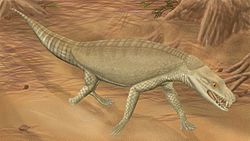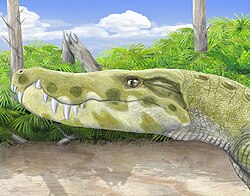| Notosuchia | |
|---|---|
 | |
| Mounted skeleton of the notosuchian Simosuchus clarki in the Royal Ontario Museum | |
| Scientific classification | |
| Kingdom: | Animalia |
| Phylum: | Chordata |
| Class: | Reptilia |
| Clade: | Archosauria |
| Clade: | Pseudosuchia |
| Clade: | Crocodylomorpha |
| Clade: | Crocodyliformes |
| Clade: | Mesoeucrocodylia |
| Clade: | Metasuchia |
| Clade: | † Notosuchia Gasparini, 1971 |
| Families and genera | |
| |
Notosuchia is a clade of primarily Gondwanan mesoeucrocodylian crocodylomorphs that lived during the Jurassic and Cretaceous. Some phylogenies recover Sebecosuchia as a clade within Notosuchia, others as a sister group (see below); if Sebecosuchia is included within Notosuchia its existence is pushed into the Late Miocene or Early Pliocene, about 7 to 4.5 million years ago. [5] Fossils have been found from South America, Africa, Asia, and Europe. Notosuchia was a clade of terrestrial crocodilians that evolved a range of feeding behaviours, including herbivory ( Chimaerasuchus ), omnivory ( Simosuchus ), and terrestrial hypercarnivory ( Baurusuchus ). It included many members with highly derived traits unusual for crocodylomorphs, including mammal-like teeth, flexible bands of shield-like body armor similar to those of armadillos ( Armadillosuchus ), and possibly fleshy cheeks and pig-like snouts ( Notosuchus ). The clade was first named in 1971 by Zulma Gasparini and has since undergone many phylogenetic revisions. [6]











